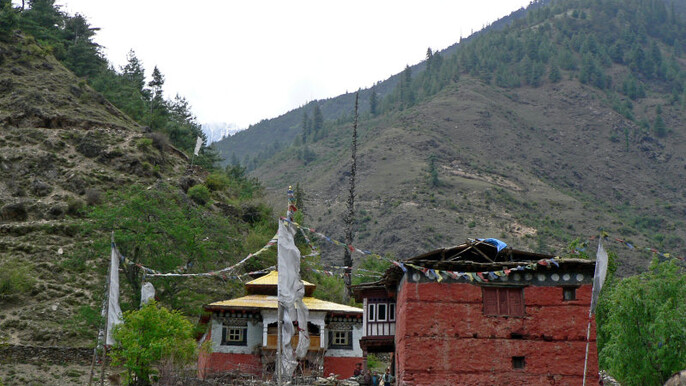Beni to Lower Dolpo Camping & Trek – 22 Days of Wild Solitude & Bon Monasteries

Description
The 22-day Beni to Lower Dolpo Camping & Trek is an off-the-grid Himalayan journey into Nepal’s most isolated and culturally untouched region. Starting in the lush lowlands of Beni, you’ll gradually ascend into the arid, mystical landscapes of Lower Dolpo, home to centuries-old Bonpo monasteries, turquoise Phoksundo Lake, and the endangered snow leopard.
This trail isn’t just a trek—it’s an expedition through time, where every step takes you deeper into raw beauty and ancient Tibetan-Nepali heritage. Prepare for wild camping beneath star-studded skies, silent passes above 5,000m, and rare access to villages unchanged for centuries.
Trek Highlights
- Diverse Landscapes: From subtropical forests near Beni to the desert-like trans-Himalayan terrain of Dolpo.
- Phoksundo Lake: A surreal turquoise lake at 3,611m, framed by waterfalls and whitewashed Bon villages.
- Bonpo Monasteries & Tibetan Culture: Explore ancient monasteries like Shey Gompa and witness pre-Buddhist Bon traditions still practiced today.
- Wildlife Encounters: Blue sheep, musk deer, Himalayan griffons, and, if lucky, a glimpse of the elusive snow leopard.
- High Pass Crossings: Challenge yourself with Jeng La Pass (5,110m) and Kagmara La Pass (5,115m) for panoramic Himalayan views.
- Wilderness Camping: Sleep in complete wilderness, far from modern distractions.
- Untouched Trails: Remote, rarely-trekked paths for true adventure seekers.
Important Information
- Difficulty: Challenging (high altitude & remote trails)
- Trek Type: Full camping with porters & crew
- Max Altitude: 5,350m (Nangdala Pass)
- Group Size: 2–12 (small group for personalized experience)
- Permits Required: Restricted Area Permit (RAP), Shey Phoksundo National Park Entry
- Best Time: Mid-May to October (dry, clear skies)
- Accommodation: Tented camping + 3night in Kathmandu hotel
- Transport: Private vehicles, local jeeps, domestic flights
Why Trek with Osho World Adventure?
- Deep knowledge of remote routes
- Local Dolpo-born guides and porters
- Quality gear, expert logistics & ethical practices
- Focused on cultural immersion, not just high points
Book this rare Himalayan experience before it books you.
Let Osho World Adventure take you where maps fade and mountains tell their stories.
Included
- 21x Breakfast,16x Dinner,16x Lunch
- Accommodation included: 21 nights
- Kathmandu International Airport Arrival & Departure Transfer by Private Comfortable Car/van/ Hiace
- Welcome and Farewell Dinner with Nepali Cultural Dance show
- Accommodations Twin Sharing Basis in Kathmandu at 3 to 4 Star hotel
- All kind of meal including breakfast, lunch and dinner during the trek with accommodation
- Round trip Land and Air Transportation as per the destination and itinerary
- English Speaking experienced Trekking Guide (Govt. Trained/Licensed Holder)
- one extra assistant trek leader for above 8 pax group. 1 porter for 2 person basis
- All official document process charges including Trek Permit,Restricted permit, TIMS card
- Insurance, Transportation, Wages, Equipments and all meals & Lodges for Porters and Guides
- One day sightseeing of Kathmandu valley
- Down Jacket, sleeping bag, Osho World Adventure trekking kit bag/duffel bag
- First Aid Kit Box
- Emergency helicopter rescue and evacuation coordination service (This is only in case of emergencies)
- One day free Yoga & Meditation Course in Kathmandu.,Government taxes & Other Applicable Fees
- Entry/Admission - NayaPul Bridge
- Entry/Admission - BENI
- Entry/Admission - Dharapani Temple
- Entry/Admission - Dhorpatan Hunting Reserve
- Entry/Admission - Nepal Telecom
- Entry/Admission - Dolpa DISTRICT COURT
Excluded
- International Airfare to and from your country
- Nepal Visa fee
- Travel & Health Insurance- Emergency Helicopter Rescue Insurance (Most recommended)
- Lunch & Dinner in Kathmandu – keep $ 5 to 10 for per meal in Tourist Restaurant
- Extra accommodation in Kathmandu in case of early return from trekking than schedule itinerary
- Any Alcoholic Drinks, Cold Drinks, Boiled & Mineral Water, Beverages, deserts Etc in Trek
- Unforeseen cost such as flight cancellation or delay, health problems and helicopter rescue
- Personal expenses, such as the phone calls, laundry service, internet, bar bills
- Any other cost, which is not mentioned above
- Tips for trekking guide
- Entry/Admission - Kathmandu Durbar Square
- Entry/Admission - Swayambhunath Stupa
- Entry/Admission - Pashupatinath Temple
- Entry/Admission - Boudhanath Stupa
Know before you go
General
- 4 seasons Sleeping bag (Optional/we can provide one if you need it but is to be returned after the trek)
- Duffel or Rucksack bag or suitcase (We will provide one complimentary ACE duffel bag for you to keep.)
- Daypack
- Down Jacket (Optional/we can provide if you need one but is to be returned after the trek)
Upper Body - Head / Ears / Eyes
- Shade hat or baseball cap – some people drape a bandana down the back of their head and then put a baseball cap on to hold it. This can be a flexible alternative while keeping the sun off your ears and neck.
- Warm wool or synthetic hat that cover your ears.
- Balaclava – lightweight, thinner variety.
- Glacier glasses-100% UV protection with side shields and a hard-sided storage case (i.e. Julbo or Cebe). This is to protect your eyes from the stronger rays of the sun due to the thinner atmosphere which can cause a painful condition known as snow blindness. Regular sunglasses are not sufficient. If you wear prescription glasses, speak to your doctor about prescription glacier glasses, perhaps with transitional lenses.
- Headlamp – Black Diamond and Petzl both make several good ones. Make sure to bring extra batteries and that they are lithium batteries so that they will last in the colder temperatures. These are indispensable for getting around at night, reading, etc. so, don’t go cheap here.
- Some people like earmuffs; These are optional; a good hat, balaclava, and hooded jacket should really be sufficient, but this is a personal choice for some people (optional).
- A neck warmer is another piece of gear for extra warmth if you feel you will need it (optional).
Hand
- 1 pair liner gloves, thin wool or synthetic, useful alone on mild days or as a layer inside other gloves/mitts for additional warmth.
- 1 pair warm gloves (heavier fleece or wool).
- 1 pair shell gloves or mitts; Gore-Tex is preferred for keeping hands dry.
- Instant hand warmers are always nice in a pinch, but really shouldn’t be necessary on the trek. Bringing appropriate hand protection as recommended above, should be sufficient (optional).
Core Body
- T-shirts (2).
- Light and expedition weight thermal tops.
- Fleece jacket or pullover.
- Fleece Wind-Stopper jacket (optional).
- Waterproof (preferably breathable fabric) shell jacket.
- 2 women sports bras, Synthetic, no cotton!
Lower Body – Legs
- 2 pairs nylon hiking shorts – Quick drying type, not cotton!
- Underwear, stay away from cotton (4).
- 2 pairs lightweight long underwear – Capilene or other synthetic.
- 1 pair soft shell pants – synthetic, full zip from top and bottom preferable.
- 2 pairs trekking pants, preferably that zip on/off at the knees so they double as shorts.
- 1 pair hard shell pants. Waterproof/breathable, Gore-Tex or equivalent is best. Should zip from the top and bottom – this makes it easier to put on over boots without getting undressed should the weather change once you are underway for the day.
- 1 pair cotton pants (loose jeans/khakis).
- All clothing should be kept dry using waterproof stuff sacks or large puncture resistant plastic bags.
Feet
- 4 pairs of liner socks, synthetic or Capilene.
- 3 pairs heavy weight socks to be worn over liner socks.
- 1 pair light weight socks, a good option for the lower / warmer parts of the trail.
- 1 pair light to medium weight waterproof hiking/trekking boots. Ensure a good fit with layered socks and you have worn them before to get used to it (otherwise you will get lots of blister).
- 1 pair light trekking shoes or sneakers. Good for around the camp/lodges and in Kathmandu.
- 1 pair hiking gaiters, good for keeping dust and rocks out of your shoes/boots as well as keep your feet dry as necessary (Optional).
- 1 pair sandals (Optional).
Medicines and First Aid Kits
(Please note our guide will also carry the first aid kit bag during the trek. However, we still recommend you to bring your personal first aid kit as well)
- Extra Strength Excedrin for altitude related headaches.
- Ibuprofen for general aches and pains.
- Immodium or Pepto Bismol capsules for upset stomach or diarrhea.
- Diamox (commonly prescribed as Acetazolamide) 125 or 250mg tablets for altitude sickness. Please discuss with us before starting to take this medicine.
- 1 small personal sized first-aid kit with blister treatments such as mole skin, band-aids, some waterproof tape, anti-infection ointments, etc. Your guides will have more extensive medical gear, but you should have the basics for general use.
Miscellaneous
- Passport and extra passport photos (4 copies).
- Airline ticket (Please make a copy and leave on at our office in Kathmandu just in case if you need to change the date of your).
- Durable wallet/pouch for travel documents, money & passport.
- Lip balm. At least SPF 20, 2 sticks. A string taped to the stick is helpful, to hang around your neck and some are now being sold with a cord already attached. Handy as it avoids you from having to stop and look for it.
- Sunscreen. SPF 40 is recommended and should be relatively new since it loses its’ effectiveness over time.
- Pocket knife or small Swiss Army type.
- Water purification Iodine tablets or Polar-pure crystals.
- Toiletry kit. Be sure to include toilet paper stored in a plastic bag, hand wipes, and liquid hand sanitizer, towel, soap, etc.
- 2 bananas.
Optional
- 1 pair adjustable trekking poles. Although these are listed as optional, these can be of great assistance to people who may think of themselves and generally clumsy or with bad knees, ankles, etc especially when going downhill.
- Favorite snack foods, no more than 2 pounds.
- Paperback books, cards, mp3 player (there are a couple of stops where you could recharge. Avoid players with moving hardware as it may not function. Remember, keep these items lightweight.
- Binoculars.
- 1 light weight point & shoot camera or 1 large SLR. Digital cameras are ok, but you must keep the batteries warm when not in use.
- Hydration bladder with drinking tube and tube insulator.
- A pee bottle for men and pee funnel for woman, some swear by them to avoid that chilly late night trip.
- 1 small stainless steel thermos.









